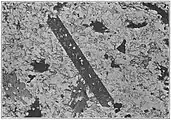| Antietam Formation | |
|---|---|
| Stratigraphic range: Cambrian | |
 Anticline in schist of Antietam Formation | |
| Type | Formation |
| Unit of | Chilhowee Group |
| Underlies | Tomstown Dolomite |
| Overlies | Harpers Formation |
| Thickness | 550 ft |
| Lithology | |
| Primary | Sandstone, quartzite |
| Other | Schist |
| Location | |
| Region | Appalachia, Eastern United States, and Southeastern United States |
| Country | United States |
| Extent | Maryland, Pennsylvania, Virginia,[1] and West Virginia |
| Type section | |
| Named for | Antietam Creek |
The Antietam Formation or Antietam Sandstone is a geologic formation in Pennsylvania, Maryland and West Virginia.[2][3][4] It is largely quartz sandstone with some quartzite and quartz schist. It preserves Skolithos trace fossils dating back to the Cambrian Period.[5]
 Tight folds in the schist of Antietam Formation
Tight folds in the schist of Antietam Formation Thin section of schist. Porphyroblastic biotite, a, in a dolomitic matrix. The tourmaline, t, is epigenetic.
Thin section of schist. Porphyroblastic biotite, a, in a dolomitic matrix. The tourmaline, t, is epigenetic.
References
- ↑ Paleozoic Sedimentary Successions of the Virginia Valley & Ridge and Plateau
- ↑ Antietam Formation in West Virginia, USGS
- ↑ Antietam Formation in Pennsylvania, USGS
- ↑ Maryland Geological Survey, Volume 10, Johns Hopkins Press, 1918 p. 200
- ↑ "Geology of West Virginia's Blue Ridge". Archived from the original on 2016-03-04. Retrieved 2015-03-25.
This article is issued from Wikipedia. The text is licensed under Creative Commons - Attribution - Sharealike. Additional terms may apply for the media files.